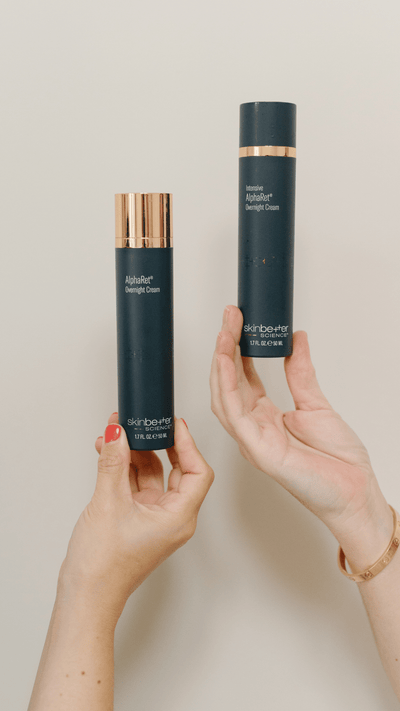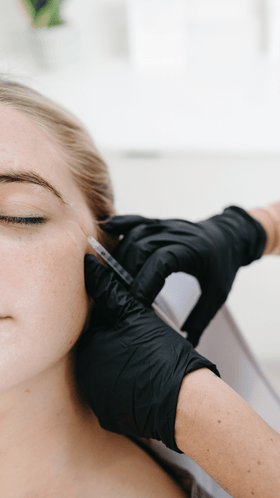
Dr Laura's Guide to Rosacea
Dr Laura’s Guide to Rosacea
Rosacea is a chronic medical condition, also known as the ‘curse of the Celts’, which appears as redness on the skin. It may look like a blush, or a flushed area of the skin. Sometimes, you may even be able to see small blood vessels beneath the skin’s surface.
It may also be accompanied by spots similar to those caused by acne, which may be red and swollen or filled with pus.
Rosacea often varies, changing from milder symptoms to severe flare ups.
If you think you may have rosacea, and are seeking rosacea treatment, it’s a good idea to firstly try to understand which type of rosacea that you have (or types, as you can unfortunately have more than one type at the same time!). This will make it easier for you to identify the best rosacea treatment options.
Types of Rosacea
Type one is called Erythematotelangiectatic Rosacea, and is characterised by redness and spider veins, which are little blood vessels visible in the skin. The redness can be milder or flare up and, with all rosacea, tends to affect the centre of your face.
In type one rosacea, this redness is mainly caused by vascular changes. This, unfortunately, means that changing your skincare routine is unlikely to have a significant impact, and laser based treatment is usually the best option.
At our Galway clinic, we use a combination of IPL (Intense Pulsed Light) and Nd:Yag laser treatments to treat broken blood vessels and overall redness caused by rosacea.
Type two is Papulo-Pustular Rosacea, which used to be known as Acne Rosacea (as it looks similar to acne, but without blackheads or whiteheads). Type two presents as spots, papules and pustules, again usually around the centre of your face.

It often presents alongside Type One, and is a combination that we often see at our clinic. The redness in Type Two is more inflammatory in nature, and so topical and oral prescription products alongside specialised skincare work well to treat this. In the clinic, we use a mixture of the above to help to treat rosacea. This is dependent on the rosacea’s severity.
By using a combination of topical prescription creams (like azaelic acid or soolantra) or oral antibiotics alongside soothing and barrier-repairing skincare ingredients to treat rosacea, we can achieve excellent results!
The third type of rosacea, or Type Three, is Rhinophyma. This tends to affect older males more than females, and presents as a swelling of the skin on the nose and other changes to the skin. This is very challenging to treat.
The final type of rosacea, Type Four is Ocular (Eye) Rosacea, and many people have elements of this. You can have Ocular Rosacea without any signs on the skin.
Rosacea Triggers
While we don’t know the underlying cause of rosacea, we do know that there are triggers which can cause a flare up or a worsening of symptoms.
These include;
- Stress
- Exercise
- Significantly hot or cold weather
- Exposure to sunlight
- Alcohol
- Caffeine
- Certain foods (e.g. spicy foods)
Rosacea Treatment Options
Although a cure for rosacea isn’t currently available, there are plenty of treatment options to ease discomfort and soothe symptoms. These can include topical treatments such as creams or gels, topical or oral prescription medication, and light treatments.

One of our favourite products for tackling rosacea, which we recommend in our Galway clinic, is iS Clinical’s Pro Heal Serum Adv+. Packed full of vitamins C, A and E, thiS Clinically proven formula delivers a hefty dose of antioxidant protection alongside remarkable healing properties.
We also recommend Skinceuticals’ Phyto A+ Brightening Treatment, as this lightweight moisturiser helps to reduce excess oil and redness while soothing skin. With ingredients including 3% Azelaic Acid and 5.75% Phyto Botanical Blend, this clever formula also improves skin clarity and tackles surface imperfections.
Dr. Laura also regularly recommends SkinCeuticals Metacell Renewal B3 to patients as part of her Rosacea Protocol. With a calming blend of 5% niacinamide and 17% glycerin, it’s great for repairing the skin barrier!
Some patients will also be able to tolerate a salicylic acid-based cleanser once or twice a week. Our favourite is the Obagi CLENZIderm Foaming Cleanser.
It’s also important not to forget SPF! Exposure to UV rays can make redness and rosacea worse, so we always recommend that our rosacea patients wear SPF 50 365 days a year - even if the weather is dull or cloudy. Our go-to products include Heliocare’s Mineral Tolerance Fluid SPF 50 and iS Clinical’s Extreme Protect SPF 40 formula.
For a more intense course of rosacea treatment, why not join Dr. Laura Clinic’s Rosacea Bootcamp?

This specialised rosacea treatment programme allows us to use our skincare expertise to heal and transform your skin with just two easy steps. First of all, we’ll focus on your skin’s health first - with prescription medications used as required as part of your rosacea treatment for up to three months.
We’ll then move on to treating the underlying redness and any vascular lesions with six sessions of IPL or laser genesis (light treatments). These light treatments are fantastic for treating rosacea - IPL is used to tackle more obvious redness, while laser genesis helps to eliminate any background redness.
We often use the iS Clinical Champagne Foaming Enzyme Facial at our Galway clinic for rosacea patients, as this helps to calm and soothe redness - and leads to incredible results!
To discuss your rosacea treatment options and find out if our Rosacea Bootcamp is right for you, why not book a consultation with Dr. Laura today?



